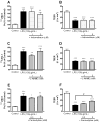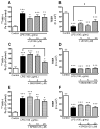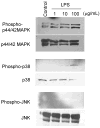Lipopolysaccharide-enhanced transcellular transport of HIV-1 across the blood-brain barrier is mediated by the p38 mitogen-activated protein kinase pathway
- PMID: 18295207
- PMCID: PMC2385783
- DOI: 10.1016/j.expneurol.2007.12.028
Lipopolysaccharide-enhanced transcellular transport of HIV-1 across the blood-brain barrier is mediated by the p38 mitogen-activated protein kinase pathway
Abstract
Chronic systemic inflammation in the late stage of human immunodeficiency virus type-1 (HIV-1) infection could increase neuroinvasion of infected monocytes and cell-free virus, causing an aggravation of neurological disorders in AIDS patients. We previously showed that the peripheral administration of lipopolysaccharide (LPS) enhanced the uptake across the blood-brain barrier (BBB) of the HIV-1 viral protein gp120. Brain microvessel endothelial cells are targets of LPS. Here, we investigated whether the direct interaction between LPS and the BBB also affected HIV-1 transport using primary mouse brain microvessel endothelial cells (BMECs). LPS produced a dose (1-100 microg/mL)- and time (0.5-4 h)-dependent increase in HIV-1 transport and a decrease in transendothelial electrical resistance (TEER). Whereas indomethacin (cyclooxygenase inhibitor) and L-NAME (NO synthase inhibitor) did not affect the LPS-induced changes in HIV-1 transport or TEER, pentoxifylline (TNF-alpha inhibitor) attenuated the decrease in TEER induced by LPS, but not the LPS-induced increase in HIV-1 transport. LPS also increased the phosphorylation of p44/42 MAPK and p38 MAPK but not that of JNK. U0126 (p44/42 MAPK inhibitor) and SP600125 (JNK inhibitor) did not inhibit the LPS-induced increase in HIV-1 transport although U0126 attenuated the reduction in TEER. SB203580 (p38 MAPK inhibitor) inhibited the LPS-induced increase in HIV-1 transport without affecting TEER. Thus, LPS-enhanced HIV-1 transport is independent of changes in TEER and so is attributed to increased transcellular trafficking of HIV-1 across the BBB. These results show that LPS increases HIV-1 transcellular transport across the BBB by a pathway that is mediated by p38 MAPK phosphorylation in BMECs.
Figures





Similar articles
-
Lipopolysaccharide-enhanced transcellular transport of HIV-1 across the blood-brain barrier is mediated by luminal microvessel IL-6 and GM-CSF.J Neuroinflammation. 2011 Nov 30;8:167. doi: 10.1186/1742-2094-8-167. J Neuroinflammation. 2011. PMID: 22129063 Free PMC article.
-
p38 but not p44/42 mitogen-activated protein kinase is required for nitric oxide synthase induction mediated by lipopolysaccharide in RAW 264.7 macrophages.Mol Pharmacol. 1999 Mar;55(3):481-8. Mol Pharmacol. 1999. PMID: 10051531
-
A critical role for p38 mitogen-activated protein kinase in the maturation of human blood-derived dendritic cells induced by lipopolysaccharide, TNF-alpha, and contact sensitizers.J Immunol. 2001 Mar 15;166(6):3837-45. doi: 10.4049/jimmunol.166.6.3837. J Immunol. 2001. PMID: 11238627
-
Induction of cyclooxygenase-2 by lipopolysaccharide in canine tracheal smooth muscle cells: involvement of p42/p44 and p38 mitogen-activated protein kinases and nuclear factor-kappaB pathways.Cell Signal. 2003 May;15(5):497-509. doi: 10.1016/s0898-6568(02)00135-3. Cell Signal. 2003. PMID: 12639713
-
The MAP kinase pathway mediates transcytosis induced by TNF-alpha in an in vitro blood-brain barrier model.Eur J Neurosci. 2005 Aug;22(4):835-44. doi: 10.1111/j.1460-9568.2005.04273.x. Eur J Neurosci. 2005. PMID: 16115207
Cited by
-
Exposure to lipopolysaccharide and/or unconjugated bilirubin impair the integrity and function of brain microvascular endothelial cells.PLoS One. 2012;7(5):e35919. doi: 10.1371/journal.pone.0035919. Epub 2012 May 7. PLoS One. 2012. PMID: 22586454 Free PMC article.
-
Alpha Adrenergic Induction of Transport of Lysosomal Enzyme across the Blood-Brain Barrier.PLoS One. 2015 Nov 6;10(11):e0142347. doi: 10.1371/journal.pone.0142347. eCollection 2015. PLoS One. 2015. PMID: 26545208 Free PMC article.
-
Brain pericytes increase the lipopolysaccharide-enhanced transcytosis of HIV-1 free virus across the in vitro blood-brain barrier: evidence for cytokine-mediated pericyte-endothelial cell crosstalk.Fluids Barriers CNS. 2013 Jul 1;10(1):23. doi: 10.1186/2045-8118-10-23. Fluids Barriers CNS. 2013. PMID: 23816186 Free PMC article.
-
Pentoxifylline reduces tumor necrosis factor-α and HIV-induced vascular endothelial activation.AIDS Res Hum Retroviruses. 2012 Oct;28(10):1207-15. doi: 10.1089/AID.2011.0385. Epub 2012 May 8. AIDS Res Hum Retroviruses. 2012. PMID: 22463742 Free PMC article.
-
Mouse models of neurological disorders: a view from the blood-brain barrier.Biochim Biophys Acta. 2010 Oct;1802(10):881-8. doi: 10.1016/j.bbadis.2009.10.011. Epub 2009 Oct 29. Biochim Biophys Acta. 2010. PMID: 19879356 Free PMC article. Review.
References
-
- Akira S, Takeda K. Toll-like receptor signaling. Nat Rev Immunol. 2004;4:499–511. - PubMed
-
- Alonso K, Pontiggia P, Medenica R, Rizzo S. Cytokine patterns in adults with AIDS. Immunol Invest. 1997;26:341–350. - PubMed
-
- András IE, Pu H, Deli MA, Nath A, Hennig B, Toborek M. HIV-1 Tat protein alters tight junction protein expression and distribution in cultured brain endothelial cells. J Neurosci Res. 2003;74:255–265. - PubMed
-
- András IE, Pu H, Tian J, Deli MA, Nath A, Hennig B, Toborek M. Signaling mechanisms of HIV-1 Tat-induced alterations of claudin-5 expression in brain endothelial cells. J Cereb Blood Flow Metab. 2005;25:1159–1170. - PubMed
-
- Banks WA, Akerstrom V, Kastin AJ. Adsorptive endocytosis mediates the passage of HIV-1 across the blood-brain barrier: evidence for a post-internalization coreceptor. J Cell Sci. 1998;111:533–540. - PubMed
Publication types
MeSH terms
Substances
Grants and funding
LinkOut - more resources
Full Text Sources
Research Materials

